Wheelhouse, Clifford James
Killed in Action 1944-04-21
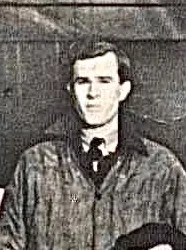

Birth Date: 1923
Born:
Son of John Henry and Emily Alice Wheelhouse of Stockton-on-Tees County Durham UK
Home: Stockton-on-Tees, County Durham UK
Enlistment:
Enlistment Date: Unknown
Service
RAFVR
Unit
420 (B) Sqn- Squadron
Pugnamus Finitum We fight to the finish
Base
RAF Tholthorpe
Rank
Pilot Officer
Position
Pilot Officer
Service Numbers
175807
Target
 Lens France
Lens France
First Burial
 Saint-Riquier-ès-Plains, France
Saint-Riquier-ès-Plains, France
Halifax B/A.Mk.III LW692
Bombing Lens France 1944-April-20 to 1944-April-21
420 (B) Sqn (RCAF) Tholthorpe Yorkshire UK
Aircraft was off course, over Dieppe, which was a heavily defended German naval port. It was expected to cross into France near Le Havre, not Dieppe. Aircraft was shot down by flak en route to attack the rail junctions at Lens, France, crashing into the marsh surrounding Scie River, Pourville-Sur-Mer, Dieppe, France. Wheelhouse, Anderson and Bourcier baled and landed just offshore. Wheelhouse drowned, Anderson and Bourcier were taken Prisoners of War. Wilson's parachute failed to open.
Leonard, Gough and Warren were missing, presumed killed. They are commemorated on the Runnymede Memorial.
An excavation of the crash site began in 2022. Original research by Bill Anderson Winnipeg
Author and Dedication
This history of Pilot Officer Robert Allan Anderson has been assembled by his son Bill Anderson and was submitted to the Canadian Warplane Heritage Museum in November 2020. Robert Allan Anderson was a Sergeant at the time of the crash. Bill Anderson's research used original source materials from the RCAF, his father's journals plus direct explanations from his father. Bill also credits veteran pilot of 420 Squadron and author, Russell McKay, in assisting him, and for the title My Dad's War.
With respect to the title "My Dad's War", I had sent the following letter and information to Russell and in the following May 23, 2009 letter to me, he remarked "Dear Mr. Anderson: I thank you for the huge amount of extremely interesting WW II information pertaining to your Father and his war". When I read those words, I immediately understood what the title of my Dad's story must be!
LW692 Crew - April 20, 1944
RCAF post war reporting:
| After capture, the Nazi's interrogate Bourcier and Anderson. A quick timeline is presented by researcher David Champion: "Plane goes down, Anderson and Bourcier are picked up. From there they take a train ride to the Dulag Luft (Luftwaffe Interrogation) centre at Oberursel, north of Frankfurt. Most fliers spent between 2-3 weeks there. Treatment ranged from pretty decent to threats to a strange scenario where the Luftwaffe stripped you of all your clothes and locked you in a room with the heat turned up high. They had an interrogator there from Kitchener, Ontario who spoke better English than some of the Canadians there. When the Fatherland called he returned to Germany." I (Bill Anderson) have never discussed the interrogation with my father Robert Anderson. However, a 1945 newspaper article that I was reading, titled 1,600 Airmen Return, Most From Captivity, it says "Shot down by flak over Dieppe in April of last year, Flying Officer Bourcier and his friend Flying Officer Bob Anderson of Winnipeg were subjected to a severe quizzing by the Nazis at a Frankfurt interrogation centre. When they refused to talk, they were sent to Stalag Luft III in Upper Silesia". Both Anderson and Bourcier were sent to the North Compound of Stalag Luft 3, Sagan Germany (now Zagan Poland), arriving shortly after 50 airmen were recaptured and murdered by the SS under the direct order of Adolph Hitler for their part in what became known as "The Great Escape". |
- Information source: Flying Officer Robert Allan Anderson , through his son Bill Anderson of Winnipeg Manitoba Canada.
- Canadian Air Force Flying Log Book for Aircrew other than Pilot All aircrew keep a log of their air time.
- Robert Anderson flew out of Tholthorpe in Halifax Bombers coded PT-A, PT-B, PT-O, PT-Q, PT-R, PT-T, PT-V and PT-Y, but mostly in PT-V. He flew out of Topcliffe in bombers coded (FD- or RV-) A G J N P X.
- Although this crew were together most of the time, some of these flights did not include each crew member (Anderson's Flight Log was used).
 Selected 420 Squadron ORBs specific to Anderson Bomber Command Museum Nanton AB
Selected 420 Squadron ORBs specific to Anderson Bomber Command Museum Nanton AB
✓ indicates entire crew pictured above on mission.
 420 Squadron day-to-day by Russell MacKay
420 Squadron day-to-day by Russell MacKay
Russell McKay of 420 Squadron wrote about operations in 420 Squadron. This document list each day from Russell McKay's book against the Fliying Log of Robert Anderson. This allows the reader to easily understand the flight log.
Bombing Missions Flown
In January 1944, Anderson was posted to the 420 "Snowy Owl" Squadron in Tholthorpe England, originally as a mid-upper gunner and later as a tail gunner in a Halifax Mark III bomber (Royal Canadian Air Force Flying Log Book for Aircrew other than Pilot).
February 15/16 1944, Halifax LW426 PT-Q bombed Berlin. Piloted by Flying Officer DH Calder, crew members were Flight sergeant. OA Ritchie, Sergeant R.E. Qunnings, Sergeant PE Bethel, Sergeant Patrick Gough, Sergeant Robert A. Anderson and Sergeant W.H. Heidman. The aircraft took off at 1729 and flew 7 hours return, landing at 2355. This was the 420 Squadrons first operational sortie out of Tholthorpe in Halifax III bombers since returning from service in North Africa flying Wellingtons. Details of the Sortie stated "11 aircraft attacked target between 2118 and 2131 hours, height 19,000 to 22,000 feet. Bombs dropped: 264 x 30 lbs., 7920 x 4 lbs. and 990 x 4 lb "X". Attack appeared to be successful but owing to all aircraft early in attack and 10/10th cloud not much could be seen. Heavy flak was slight and in barrage form searchlights not effective. Some aircraft report fire glow could be seen against cloud. All aircraft landed away from base". According to Anderson's Flying Log, PT-Q landed at Hethel and returned to Tholthorpe, 195 miles away, on February 20, piloted by Flight Sergeant Leonard. 1:00 Flying Time day. All Dates, Aircraft, Crew, Flight Times and Details of Sortie from Operations Record Book, Bomber Command Museum of Canada Archives
✓ February 25/26, Halifax LW366 PT-V bombed Augsburg. Piloted by Warrant Officer Class 2 Raymond Leonard (An's Flying Log indicates Flight Sergeant Leonard), crew members were Warrant Officer Class 2 Clarke Wilson Flight Sergeant Alfred Warren, Sergeant Clifford Wheelhouse, Sergeant Paul Bourcier, Sergeant Robert Anderson and Sergeant Patrick Gough. The aircraft took off at 2130 hours and flew 7.29 hours, landing at 04:47 hours. Details of the Sortie stated "Attacked between 0113 and 0123 hours, height 22,000 to 23,500 feet. Bombs incendiaries. Crews report fires all over the town with large columns of black smoke rising up to 16,000 feet. The P.F.F. were on time and the markers were well concentrated. Weather over target was clear with slight ground haze, probably smoke. All aircraft attempted photographs. A few fighters were in the target area". Anderson's Flying Log shows "Diverted - 28/2/44 Return From Diversion 1:00 (Flying Time Day).
March 7/8, Halifax LW382 PT-Q bombed Lemans. Piloted by Warrant Officer Class 2 Raymond Leonard, crew members were Warrant Officer Class 2 Clarke Wilson Flight Sergeant Alfred Warren, Sergeant Clifford Wheelhouse, Sergeant Paul Bourcier, Sergeant Robert Anderson and Sergeant R.K. Wyatt. The aircraft took off at 1848 hours and flew 5.15 hours return, landing at 0002 hours. Details of the Sortie stated "Five aircraft attacked target from 2123 to 2147 hours, from 12,000 feet. Bombs, 6x1000 + 9x500. PFF markers were absent at Wave zero hours, causing large numbers of aircraft to circle over approximate target area waiting for markers. This caused the majority of aircraft to bomb late. Number of bomb bursts and flashes soon reflected on clouds. Large explosion white turning red in colour, seen. Weather 10/10th cloud overf target, tops 6/8000 ft".
✓ March 11 Training Flight, Halifax LW386 PT-A piloted by Warrant Officer Class 2 Raymond Leonard and with crew members Warrant Officer Class 2 Clarke Wilson, Flight Sergeant Alfred Warren, Sergeant Clifford Wheelhouse, Sergeant Paul Bourcier, Sergeant Robert Anderson and Sergeant Patrick Gough, participated in a short fighter affiliation exercise.
✓ March 24/25, Halifax LW692 PT-V, piloted by Warrant Officer Class 2 Raymond Leonard and with crew members Warrant Officer Class 2 Clarke Wilson, Flight Sergeant Alfred Warren, Sergeant Clifford Wheelhouse, Sergeant Paul Bourcier, Sergeant Robert Anderson and Sergeant Patrick Gough, set off for "Target Berlin". The aircraft took off at 1851 hours but was forced to return early due to undercarriage problems. It flew 2.35 hours, landing at 21:25 hours.
✓ March 26/27, Halifax LW590 PT-R, piloted by Warrant Officer Class 2 Raymond Leonard, bombed Essen. Crew members were Warrant Officer Class 2 Clarke Wilson Flight Sergeant Alfred Warren, Sergeant Clifford Wheelhouse, Sergeant Paul Bourcier, Sergeant Robert Anderson and Sergeant Patrick Gough. The aircraft took off at 2021 hours and flew 5.00 hours, landing at 0123 hours. Details of the Sortie stated "13 aircraft attacked target from 24,000 feet between 2202 and 2216 hours. Black smoke rising to 22,000 feet H/F lights to moderate in barrage form up to 24,000 feet. Weather 10/10th clouds in layers 8,000 feet".
March 30/31, Halifax LW692 PT-V, piloted by Warrant Officer Class 2 Raymond Leonard, bombed Nuremberg. Crew members were Warrant Officer Class 2 Clarke Wilson, Flight Sergeant Alfred Warren, Sergeant Clifford Wheelhouse, Sergeant JOB Masse, Sergeant Robert Anderson and Sergeant Patrick Gough. The aircraft took off at 2208 hours, flew 7:39 hours return and landed at 05:39 hours. Details of the Sortie stated "12 aircraft attacked, two returned early, between 01:15 and 0125 hours from 20,000 feet, Bombs 50 x 30, 100 x 4. Attack appeared successful with PFF, markers and flares rather widely spread. Several crews reported explosions. Weather: was 5/10th 10/10th thin at 20,000 feet with thin layer of clouds about 10,000 feet. Landed at Ford". Russell McKay told me (Bill Anderson) that he missed the Nuremberg Raid because he was getting his appendix out in Scotland.
While the Bomber Command Operations Record Book, 420 (R.C.A.F.) Squadron, Form 541 states that the raid was successful, of the 782 bombers that took part in the raid, 96 bombers and 545 crewmen were lost, more than the total that died during the entire battle of Britain!
Martin Middlebrook, in his book "The Nuremberg Raid", states "Sir Arthur Harris, Commander-in-Chief of Bomber Command "¦ remained convinced that all-out attacks against the major cities would be the decisive factor in bringing the war to an end. He had anticipated that by 1 April 1944 his bombers would have caused in Germany "a state of devastation in which surrender is inevitable'. On the night of March 30, on what should have been a routine "maximum effort' raid to Nuremberg, Bomber Command suffered its heaviest loss of the war. Out of 779 bombers on the raid 96 were missing, while due to weather conditions over the target area Nuremberg was only lightly damaged."
In a letter home to his father, dated April 2/44, Anderson said, "I don't know where you got the idea that Luftwaffe was nearly dead. I got a kick when you said that ops over enemy territory would soon be just a ride. It sounds good to hear of terrific Nazi fighter losses but never underestimate your enemy. I think the Luftwaffe is a long way from dead, but I hope I am wrong. The boys sure took a beating the other nite by losing 97 kites, it was from fighters too. There was no flak at all. I know, I was there. We had a good trip and laid our eggs on the target ok. It was a lovely night. Moon light, that was the trouble, visibility was too good. It was so good that the Bomb Aimer got a pin point on the Rhine river and that's something. It gives me a thrill every time we cross the enemy coast you can see it so plain".
In his book, Middlebrook also quotes Anderson saying, "The only thing the Nuremberg Raid achieved was probably to raise morale in the Third Reich".
In another letter home to his father dated April 17/44, Anderson noted that while his aircraft was in the hangar getting its landing gear checked over, he stated that he "was looking it over and found a fair sized chunk of shrapnel sticking in her". He took out a screwdriver, dug it out and said that he would keep it as a souvenir and show it to you after the war. He then added, "We must have picked it up at Nuremberg" and also noted that he would be 20 years old in six days.
April 9/10, Halifax NA509 PT-B, piloted by Warrant Officer Class 2 Raymond Leonard, bombed Villeneuve St. George. Crew members were Warrant Officer Class 2 Clarke Wilson, Flight Sergeant Alfred Warren, Sergeant Clifford Wheelhouse, Sergeant N.C. Lewis, Sergeant Robert Anderson and Sergeant Patrick Gough. The aircraft took off at 2053 hours and flew 5.25 hours, landing at 0214 hours. Details of the Sortie stated "Bombs 6 x 1000, 8 x 500 M.O., Attacked target at 0004 hrs. from 15,000 feet. Markers, TK. Red and green both, also ground detail clearly visible. Bombing appeared to be well concentrated around T.I. A large explosion lasting for several seconds seen. George U/S. Monixa U/S. Good trip - target clearly visible".
April 10/11, Halifax LW692 PT-V, piloted by Warrant Officer Class 2 Raymond Leonard, bombed Ghent. Crew members were Warrant Officer Class 2 Clarke Wilson, Flight Sergeant Alfred Warren, Sergeant Clifford Wheelhouse, Sergeant JOB Masse, Sergeant Robert Anderson and Sergeant Patrick Gough. The aircraft took off at 2045 hours and flew 3.50 hours, landing at 0036 hours. Details of the Sortie stated "Bombs 9 x 1000, 6 x 500, M.G. Attacked target at 2251 hrs. from 13,000 feet. Some of the bombing seemed to be going to the south of the markers, but the raid seemed fairly good. P.F.F. were bang on time and the raid should be successful".
✓ April 18/19, Halifax LW692 PT-V, piloted by Warrant Officer Class 2 Raymond Leonard, bombed Noisy Le Sec. Crew members were Warrant Officer Class 2 Clarke Wilson, Flight Sergeant Alfred Warren, Sergeant Clifford Wheelhouse, Sergeant Paul Bourcier, Sergeant Robert Anderson and Sergeant Patrick Gough. The aircraft took off at 2104 hours and flew 5.25 hours, landing at 02:29 hours. Details of the Sortie stated "Bombs 6 x 1000, 9 x 500, M.C. Attacked target at 0000 1/4 hrs. from 15,000 feet PFF well concentrated. Large yellow explosion seen at 0007 hrs. PFF seemed bang on. Appeared to be a good shot. Friendly aircraft seen to blow up in front of us".
April 20, 1944 - Hit By Flak
✓ April 20 1944, Halifax LW692 PT-V, again piloted by Warrant Officer Second Class Raymond Leonard and with crew members Warrant Officer Second Class Clarke Wilson, Flight Sergeant Alfred Warren, Sergeant Clifford Wheelhouse, Sergeant Paul Bourcier, Sergeant Robert Anderson and Sergeant Patrick Gough, took off to attack the rail facilities at Lens France. LW692 PT-V, carrying a bomb load of 9 x 1000 and 6 x 500 pounds of high explosives, was shot down that evening by flak. Details Of Sortie Or Flight notes state "Missing. Nothing has been heard of this aircraft since take-off".
Weather described by other crew as "Thin Cloud 6/10th to 8/10th tops 5,000 ft."
Of the 154 Halifax bombers that took off, LW692 was the only aircraft that failed to return that night. Robert Anderson and Paul Bourcier, the mid-upper gunner, were its only survivors.
Sergeant Robert Anderson described the event as follows:
"We flew down to south England and over the channel. Reached enemy coast 10 minutes early and off track, we passed over very near Dieppe. They threw up a lot of flak and we got 3 hits, the plane shuddered, slowed down and lost height fast. Port engines went on fire, spread to whole wing, engineer admitted it was hopeless, skipper said bale out.
I got to escape hatch after mid upper gunner and jumped after him, plane was diving very fast and had trouble to get out of slipstream. Saw the plane spiral down on fire and crash. I landed in the mouth of a small river (Scie River) near Dieppe, had to use my Mae West, not a scratch."
Sergeant Paul Bourcier's account stated:
"After taking off and setting course for Southern England and then the channel we got off course and reached the enemy coast ten minutes before time over Dieppe, which was about 20 miles off course, as Le Havre was the crossing point.
We were picked up by radar and we were hit 3 times by flak, causing trouble to port engines, the necessary measures were taken, but fire started, and spreading rapidly on the port wing, I was then given order to bale out, which I did and by doing so landed safely. Out of front hatch."
 Returned Escape Evader Report on LW692
Returned Escape Evader Report on LW692
A witness who spoke with French Researcher Laurent Viton, said that he saw the aircraft explode just over a marshy estuary of the Scie River at Pourville France. The crater that was left is not only visible in the 1947 aerial photograph shown below which was taken by the French Geographical Survey (Institute Geographique National), but remains visible today.
Laurent also stated "It couldn't be seen in 1944 as the area was flooded by the Germans to prevent an allied landing after the disastrous Jubilee (Dieppe) Raid in 1942 and as a forbidden area, locals were not allowed going close to the coast".
On June 28th, 1945, a letter was sent to Raymond Leonard's Father indicating that a Royal Air Force and Dominion Air Force Missing Research and Inquiry Service had been organized for the purpose of research and inquiry in liberated territories into the circumstances of aircrews reported as casualties. (see links below)
postpresumptionmemorandum.jpg image not foundCASE CLOSED
On November 26th 1947, a letter from the Undersecretary of State, Air Ministry, London stated that the Graves Registration Service of the War Office found that the St. Riquier es Plains Cemetery to be unsuitable and on March 2nd, 1948, a letter was sent from the R.C.A.F Casualty Officer in Ottawa to Mr. Wilson confirming that his son had been re-interred in the Grandcourt British Military Cemetery, 19 miles East Southeast of Dieppe and that his son lies at rest in Row E, Grave No 5. (see links below)
R E F E R E N C E | Official Correspondence On The RCAF Crew Members Who Died In the LW692 Crash (source Ancestry.ca)
|
Handley Page Halifax

The Handley Page Halifax is a British Royal Air Force (RAF) four-engined heavy bomber of the Second World War. It was developed by Handley Page to the same specification as the contemporary twin-engine Avro Manchester.
The Halifax has its origins in the twin-engine HP56 proposal of the late 1930s, produced in response to the British Air Ministry's Specification P.13/36 for a capable medium bomber for "world-wide use." The HP56 was ordered as a backup to the Avro 679, both aircraft being designed to use the underperforming Rolls-Royce Vulture engine. The Handley Page design was altered at the Ministry to a four-engine arrangement powered by the Rolls-Royce Merlin engine; the rival Avro 679 was produced as the twin-engine Avro Manchester which, while regarded as unsuccessful mainly due to the Vulture engine, was a direct predecessor of the famed Avro Lancaster. Both the Lancaster and the Halifax would emerge as capable four-engined strategic bombers, thousands of which would be built and operated by the RAF and several other services during the War.
On 25 October 1939, the Halifax performed its maiden flight, and it entered service with the RAF on 13 November 1940. It quickly became a major component of Bomber Command, performing routine strategic bombing missions against the Axis Powers, many of them at night. Arthur Harris, the Air Officer Commanding-in-Chief of Bomber Command, described the Halifax as inferior to the rival Lancaster (in part due to its smaller payload) though this opinion was not shared by many of the crews that flew it, particularly for the MkIII variant. Nevertheless, production of the Halifax continued until April 1945. During their service with Bomber Command, Halifaxes flew a total of 82,773 operations and dropped 224,207 tons of bombs, while 1,833 aircraft were lost. The Halifax was also flown in large numbers by other Allied and Commonwealth nations, such as the Royal Canadian Air Force (RCAF), Royal Australian Air Force (RAAF), Free French Air Force and Polish forces.Wikipedia
 National Air Force Museum of Canada
National Air Force Museum of Canada
420 (B) Sqn Pugnamus Finitum ("Snowy Owl")
History of the Squadron during World War II (Aircraft: Hampden I, Wellington III, X, Halifax III, Lancaster X)
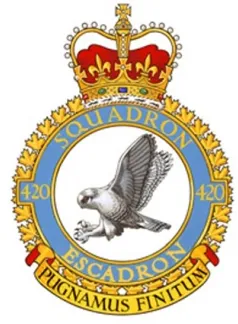
420 Squadron RCAF was the fourth RCAF bomber unit formed overseas in WWII. It was formed at Waddington, Lincolnshire, UK on December 19, 1941 as a unit of No 5 Group of RAF Bomber Command flying Handley Page Hampden Mk 1 aircraft, with the squadron code letters PT. In early August 1942 the squadron transferred to No 4 Group of Bomber Command, and was based at Skipton-on-Swale, Yorkshire : at this time it was equipped with Vickers Wellington Mk. III aircraft. In October 1942 it moved to Middleton St. George, Durham , where on January 1, 1943 it became a unit of the newly-created no. 6 (RCAF) Group of Bomber Command. It remained there until May 1943, when, by now flying tropicalized Wellington Mk X aircraft, it flew to Tunisia in North Africa to join No 331 (RCAF) Wing of No. 205 Group. From the bases of Kairouan/Zina and Hani East Landing Ground (both locations approximate)it attacked targets in Sicily and Italy as part of the invasion force. In October, the squadron returned by sea to England, leaving its aircraft behind, and rejoined 6 Group at Dalton, Yorkshire, re-equipping with Handley Page Halifax Mk. III aircraft. The squadron finally moved to Tholthorpe, Yorkshire in December 1943, where it remained until the end of hostilities in Europe. From April 1945 the squadron re-equipped with Lancaster Mk. X aircraft, although they were not used operationally. In June 1945 the squadron flew its aircraft to Debert, Nova Scotia , where it disbanded in September of 1945
In the course of hostilities, the squadron flew 4186 sorties for the loss of 65 aircraft. 9771 tons of bombs were dropped. The squadron won 38 DFC's, 1 Bar to DFC, and 9 DFM's. Battle Honors were: English Channel and North Sea 1942-44, Baltic 1942, Fortress Europe 1942-44, France and Germany 1944-45, Biscay Ports 1942-44, Ruhr 1942-45, Berlin 1944, German Ports 1942-45, Normandy 1944, Rhine, Biscay 1942-43, Sicily 1943, Italy 1943, SalernoWikipedia, Kostenuk and Griffin, Moyes
 420 Squadron History (Bomber Command Museum (Large PDF)
420 Squadron History (Bomber Command Museum (Large PDF)
 420 Tholthorpe Airfield Operations Record Book
420 Tholthorpe Airfield Operations Record Book
 420 Squadron Operations Record Book
420 Squadron Operations Record Book
Maps for Movements of 420 Squadron 1941-45
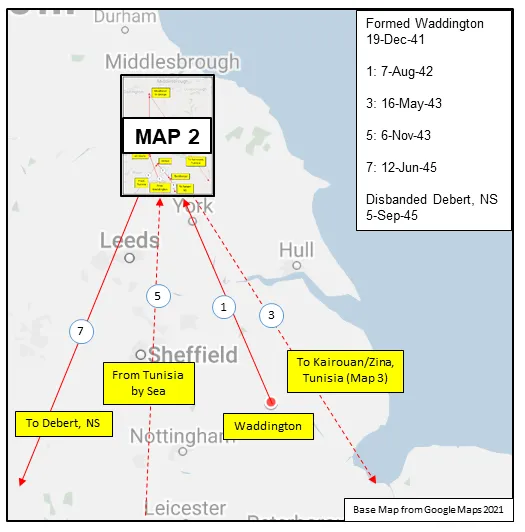 MAP 1: 420 Squadron Movements in England 1941-45 (right-click on image to display enlarged new tab) | 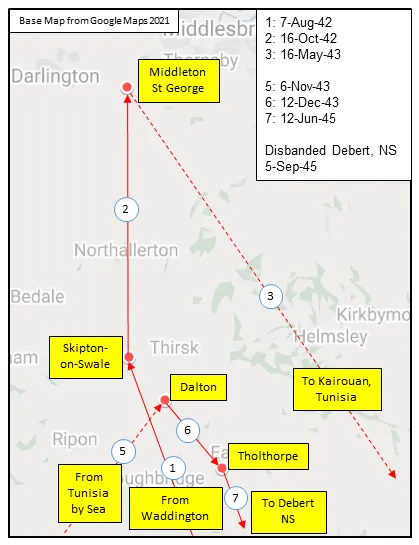 MAP 2: 420 Squadron Movements in Yorkshire and Durham 1942-45 | 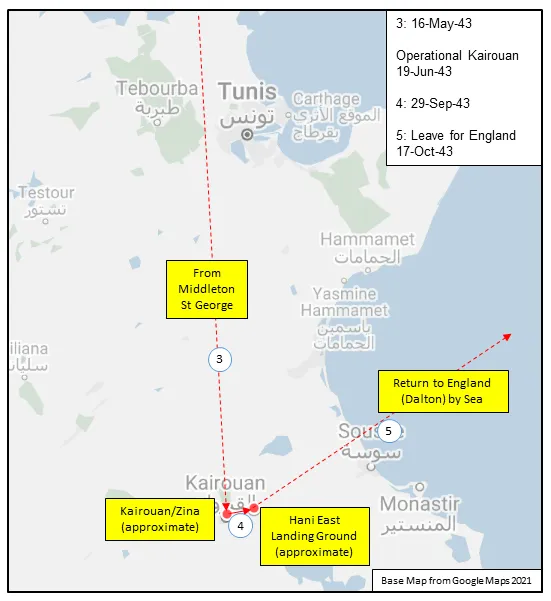 MAP 3: 420 Squadron Movements in Tunisia, North Africa 1943 |
420 Squadron History Summary 1941-45
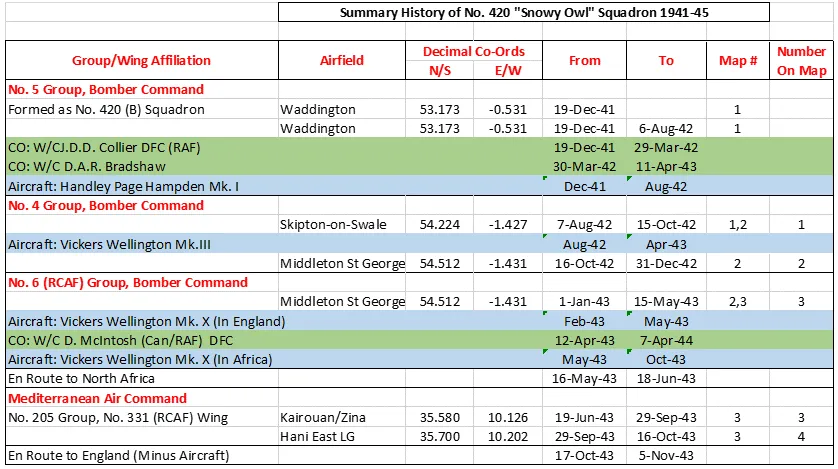
420 Squadron History Summary 1941-45 Page 2
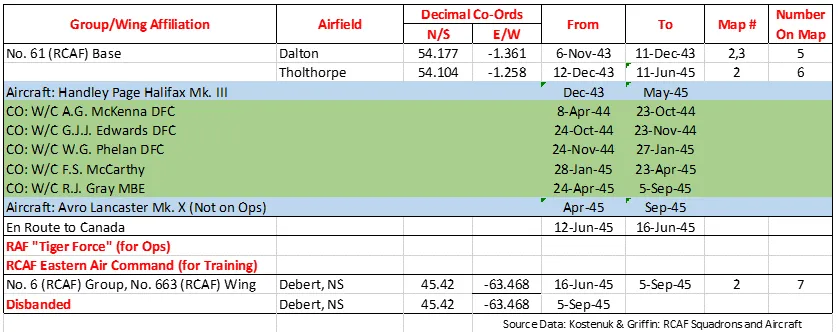
History of the Squadron Post-WWII (Aircraft: Harvard, Mustang, Silver Star, Tracker)
No. 420 Squadron reformed at London, Ontario on 15 September 1948, and flew North American Mustang and Harvard aircraft in a fighter role until the squadron disbanded on 1 September 1956. The squadron was re-formed as an Air Reserve squadron based initially at CFB Shearwater, Nova Scotia flying the de Havilland Canada Tracker aircraft that had once been the backbone of the Canadian Naval Air's anti-submarine program. As an Air Reserve Squadron it participated with regular fisheries patrols. It was one of the few active Air Reserve Squadrons in Canada and was paired with the Regular Force's 880 Squadron. The Squadron was rebased to CFB Summerside, Prince Edward Island when their base was downsized. No 420 Squadron was reduced to nil strength on 15 May 1995.
 Commonwealth War Graves Commission Certificate
Commonwealth War Graves Commission Certificate Commonwealth War Graves Commission
Commonwealth War Graves Commission www.findagrave.com
www.findagrave.com Inside a Halifax Bomber
Inside a Halifax Bomber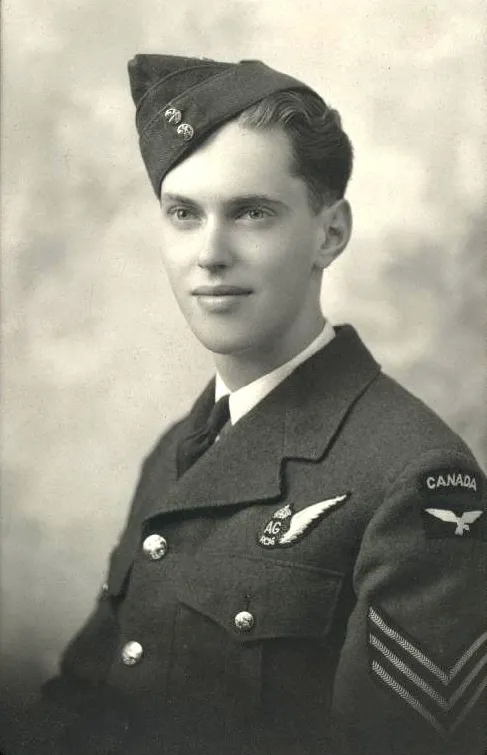

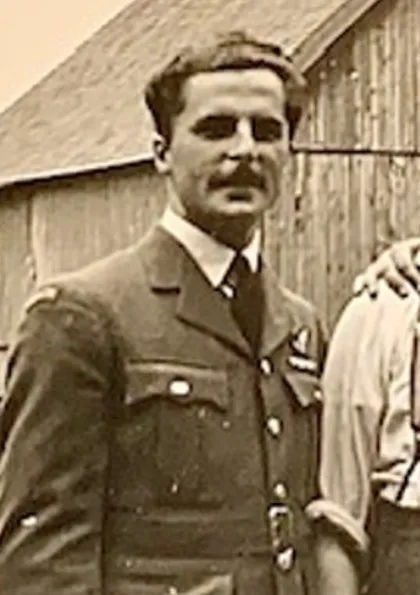
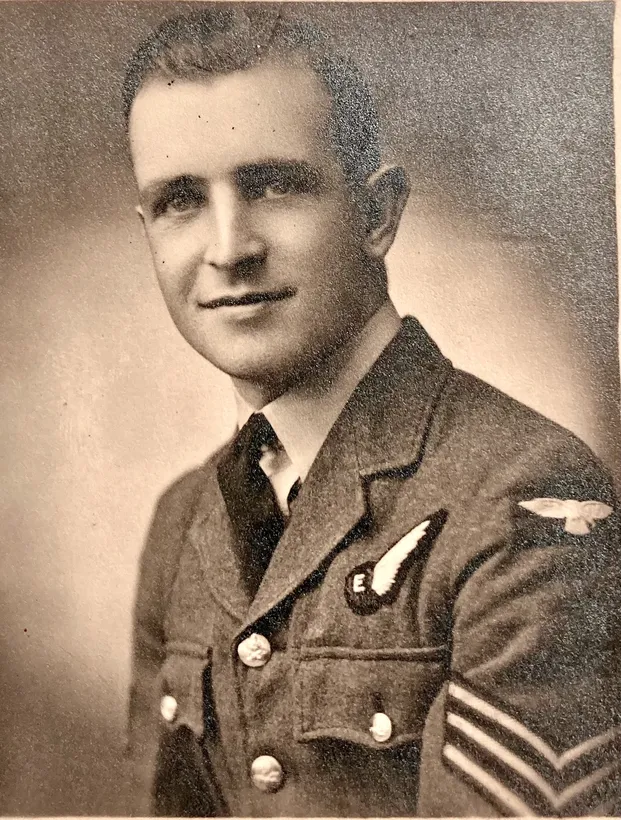
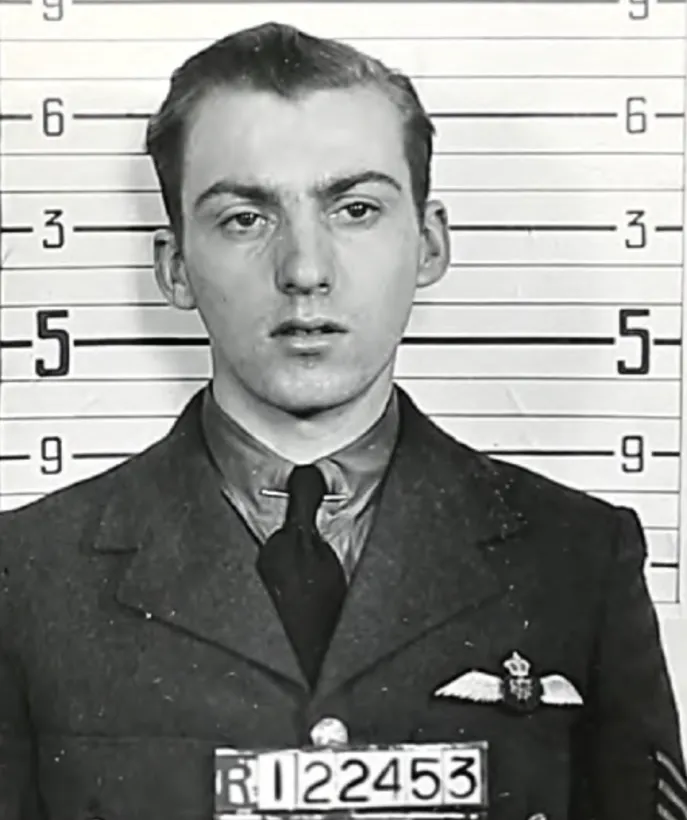
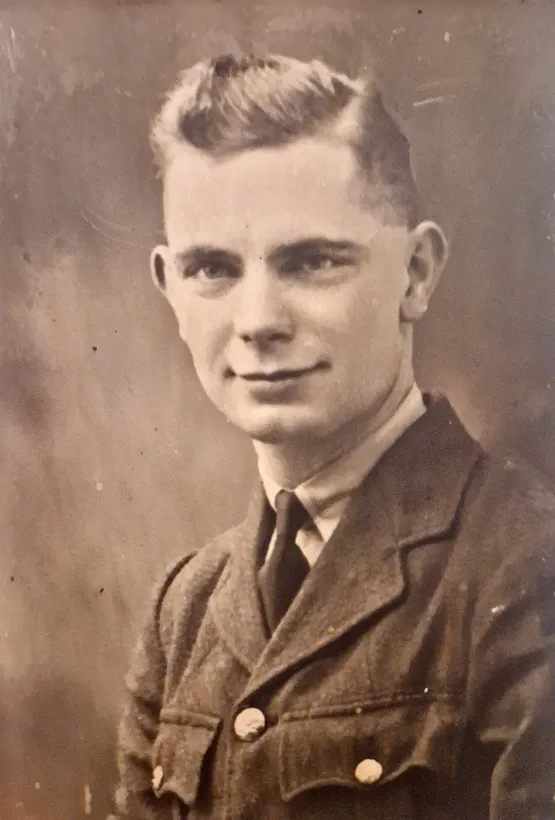
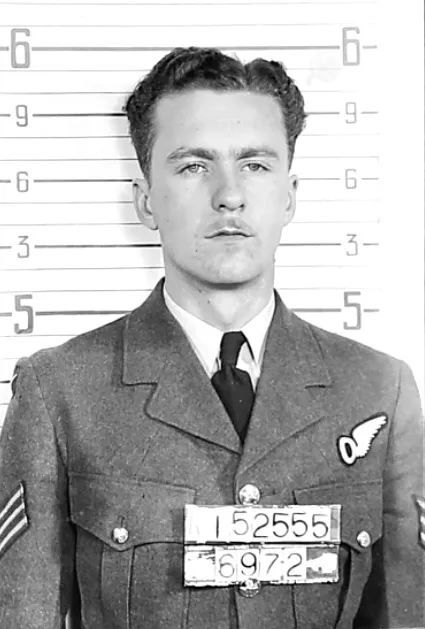
 Wikipedia Halifax Bomber
Wikipedia Halifax Bomber